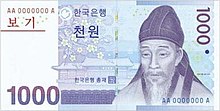Wikijunior:Asia/South Korea

South Korea is a country that is hilly and mountainous and much of the uplands of the Korean Peninsula remain forested. Koreans are thought to be descended from several Mongol tribes that migrated from Central Asia. South Korea are formed after World War 2, after which Japanese occupation ends with Soviet troops occupying area north of the 38th parallel, and US troops in the south.South declares independence in 1950 sparking North Korean invasion. The armistice ends Korean War, which has cost two million lives.
The capital city of South Korea is Seoul and the currency used is Won.
Where is South Korea?
editSouth Korea is located on the southern part of the Korean Peninsula and bordering north to North Korea. It has coastlines along the Sea of Japan to its west and the Yellow Sea to its east.
How many people live in South Korea?
edit48 million people live in South Korea according to a 2010 census. The Korean society is almost homogeneous (consist of single race) and almost 99% of South Koreans identify as ethnically Korean. The largest group of ethnic minorities in South Korea, the Chinese, only number around 20,000 people.
What are the most common languages in South Korea?
editThe Korean language, written in a script called Hangul, is the most common language for South Korea. In different areas of South Korea you’ll find that different dialects are spoken. For example, the Gyeongsang dialect spoken around Busan and Daegu to the south sounds quite rough and aggressive compared to standard Korean. Written Korean is also unique, using a phonetic system called hangul. It stacks sounds into blocks that represent syllables, and its consistency means it's fairly easy to pick up.
What is the most common religion in South Korea?
editHistorically, several religions prevailed in the Ancient Korea: shamanism (the religious belief in gods, demons, and ancestral spirits responsive to a priest, or shaman), Buddhism, Daoism, and Confucianism. The principles and social outlook of Confucianism are still much in evidence in Korean daily life and family relationships, and Buddhism remains influential—even among people who may be nominally Christian.
Approximately 25% of the population professes Christianity, with Protestants (particularly Presbyterians and Methodists), independent Christians, and Roman Catholics the largest groups. Less than 15% of the population is Buddhist.
What sports are played in South Korea?
editThe national sport in South Korea is Taekwando (taekkyon) is the art of self defense that originated in Korea. It is recognized as one of the oldest forms of martial arts in the world, reaching back over 2,000 years.
During the 20th century, there were five major martial art academies or Kwans. They were called Mooduk Kwan, Jido Kwan, Changmu Kwan, Chungdo Kwan, and Songmu Kwan. Within these schools lie a variety of styles such as KongSooDo, Tae Kyon, SooBakDo, TangSooDo, KwonPup, etc. The way of teaching and employing many of the techniques varied as much as the schools and in 1946 an attempt was made to unify Dojangs (training halls) and standardize instructional methods. Some of the leaders wanted to uphold the martial art character of the schools while others wished to create a combat sport. These meetings met with no success.
In 1955 a board of instructors, historians and prominent society members sat down to coordinate all the schools and select a name for the hopefully unified art. In April 1955 a new name was from a group of names by the board, it was Taekwondo.
The name was selected for its appropriate description of the art: Tae (foot), Kwon (hand / fist), Do (art). Literally , Taekwondo meant "the art of the foot and hand/fist"
There are few rules related to Tae Kwan Do:
(1) The aim of taekwondo is to land as many kicks and blows as you can on your opponent in the allowed target areas.
(2) A taekwondo contest comprises three rounds of two minutes each – with a one-minute break between each round.
(3) The whole taekwondo contest area is a 10m square mat.
(4) One point is scored for each legitimate strike on the body, and two points are given for kicks to the face.
What are some important sites?
edit-
Lake in Jeju Island
-
Gyeongbokgung Palace
-
Gyeonggijeon Shrine
Jeju Island - Located off the southern coast of South Korea, it is nicknamed Island of the Gods.Jeju is a subtropical destination known as one of the top honeymoon and vacation spots in South Korea.
Gyeongbokgung Palace - Built in 1395, Gyeongbokgung Palace is also commonly referred to as the Northern Palace because its location is furthest north when compared to the neighboring palaces of Changdeokgung (Eastern Palace) and Gyeonghuigung (Western Palace) Palace. Gyeongbokgung Palace is arguably the most beautiful, and remains the largest of all palaces in South Korea.
Gyeonggijeon Shrine - Built in 1410 and holds the portrait of King Tae-jo, the founder of the Joseon Dynasty. The King and his wife’s mortuary tablets are enshrined here at Jogyeong Shrine.
| Wikijunior:Asia | edit | ||

